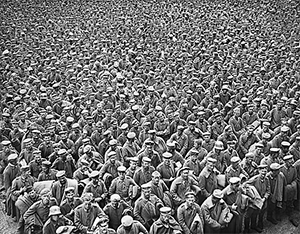The Hundred Days Offensive
The Hundred Days Offensive was a series of Allied attacks that led directly to the end of World War I. 
The German Army had launched a series of offensives in March 1918, driving strongly through a series of gaps in the line and coming as close to Paris as they had in the early days of the war, when Allied forces triumphed in the First Battle of the Marne. Those had ended in June. Another German attack, on the Marne, began the following month. That stalled. Allied forces then mounted a counterattack, which included the pivotal Battle of Soissons. French forces there disrupted German supply lines and pushed the German attackers backward. It had begun with the Battle of Amiens, in which Allied forces achieved a rare surprise in attacking the German positions. Allied troops broke through the lines, allowing tanks to storm into the rear of the German line south of the Somme, creating a 15-mile-wide gap. Another battle along that river followed, and then Allied forces broke progressively more through the Hindenburg Line. By early August, Allied forces reversed the progress that the German forces had made during their Spring Offensives. The Allied side had suffered large amounts of casualties but had many more men and weapons waiting in the wings. The German side, too, had suffered large amounts of casualties but had dwindling resources on which to draw. 
Allied forces cooperated in a number of large counterattacks, driving the German forces back and back again. More than 500 tanks featured in the Battle of Amiens, which began on August 8 and created a 15-mile-wide gap in the German line. The defenders pulled back, to the Hindenburg Line. Allied troops (by this time including Australian, Canadian, and Belgian forces) struck the German positions again and again, disrupting communication and supply lines and wearing down an already weary army. A pair of British armies broke through the Hindenburg Line on October 8, in the Second Battle of Cambrai. Their momentum building, Allied troops carried on, rolling back German gains made in the first months of the war. Battles large and small punctuated the overall picture of the tide of war rolling eastward, back toward Germany. Finally, both sides agreed to an armistice, which took effect on 11 a.m. on November 11. Estimates of casualties during the Hundred Days Offensive differ widely. Most sources agree that the German side lost more than the Allied side and that each side suffered more than 1 million casualties in those 100 days alone. |
|
Social Studies for Kids
copyright 2002–2025
David White




